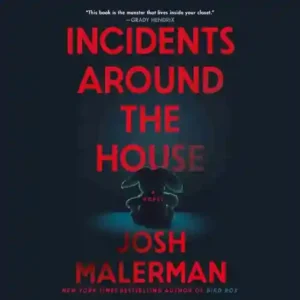
Here are the This time, I’m eager to dig into Josh Malerman’s most recent work, Incidents Around the House. For those acquainted with my literary adventures, this review is simply one of many—another foray into the fascinating realm of horror literature. Like many others, I’ve been obsessed with Malerman’s work since Bird Box grabbed the globe by storm. His unique combination of psychological horror and otherworldly aspects appeals to people who want more than simply a jump scare.
Why are there incidents around the house? To be honest, I was drawn to this one because of its disturbing concept and Malerman’s reputation for writing unnerving stories that stay long beyond the last page or, in this instance, the last audio installment. The thought of a family being plagued not just by a haunting presence but also by something closely connected to their kid quickly reminded me of Henry James’ The Turn of the Screw, another story in which the lines between reality and the supernatural are dangerously blurred.
As a lover of horror audiobooks, I was excited to see how the narration would bring this horrific story to life. After listening to and reviewing countless audiobooks, I’ve come to understand how a narrator can make or break an experience. Incidents Around the House looked like the ideal chance to explore whether Malerman’s narrative combined with a talented narrator might result in anything genuinely memorable.
So, grab your headphones, relax down, and let’s explore Incidents Around the House—a tale that may have you wondering what’s real and what’s imagined in the shadows of your own house.
Audiobook Narration: Setting the Tone
Before we go into the narrative, it’s necessary to talk about the audiobook experience, since it might vary dramatically from reading the written word. The narration for Incidents Around the House is provided by an experienced voice actor, whose identity I was unable to confirm owing to access restrictions. However, the skill with which the narrative is told has a lasting impression. The voice puts the protagonist’s horror and perplexity to life in a way that words alone cannot.
The narrator’s ability to transition between several individuals’ voices—particularly the ominous “Other Mommy”—adds an almost cinematic dimension of fear. The rhythm is also well maintained, with periods of calm suspense bursting into unexpected, scary confrontations that will undoubtedly make you jump if you listen alone in the dark. In this regard, the audiobook succeeds in enhancing Malerman’s narrative, transforming what might be a slow-burning work into a tense experience that is difficult to put down.
Plot Summary: A Haunting Like No Other
Incidents Around the House is a disturbing story about a little girl called Bela and her unstable family. Bela, just eight years old, is the prism through which we see the developing tragedy. The narrative takes place in a suburban home that becomes the focal point of supernatural happenings, sparked by the emergence of a person known as “Other Mommy.”
Bela’s world is simple—there’s Mommy, Daddo (her love nickname for her father), and their comfortable house. But things take a nasty turn when Bela meets “Other Mommy,” a ghostly entity who seems to be a benign imaginary friend but quickly displays darker intents.
Malerman brilliantly creates a story in which the boundaries between Bela’s fantasy and reality are continuously blurred. The persona of “Other Mommy” is especially distressing because she is a perverted mirror of Bela’s own mother, encapsulating everything a kid worries may lie under a parent’s reassuring surface. Bela’s meetings with “Other Mommy” were first rejected by her parents as the result of an overactive imagination, but they quickly became hard to ignore, sparking a series of scary happenings around the home.
Themes and Analysis: Childhood Innocence and the Unseen
Incidents Around the House stands apart in the horror genre because it focuses on childlike innocence tarnished by unexplainable evil. The story draws on a ubiquitous fear: that children, because to their frailty, are more susceptible to the supernatural or are even targeted by it. Bela’s point of view is key here; her narrative is both appealing and disturbing, as her innocence contrasts sharply with the atrocities she narrates.
The narrative also centers on the subject of disbelief. Bela’s parents, like many real-life people, first disregard their child’s concerns, justifying them until the evidence becomes overwhelming. This represents a wider remark on how society often dismisses young people’s anxieties, even when they are justified or, in this instance, all too true.
Malerman’s use of the home as a setting is also worth mentioning. In horror fiction, houses are often used as emblems of safety turned inside out, and Incidents Around the House is no different. The home, once a safe haven for Bela and her family, has become a prison, with every creak and shadow indicating a terrible spirit that stalks them.
Unraveling the Mystery: The Evolution of Horror
As the novel proceeds, the feeling of dread that pervades Incidents Around the House becomes stronger. Josh Malerman’s pace is methodical and patient, enabling tension to develop steadily. The early chapters are full of subtle, unnerving events—objects moving on their own, mysterious sounds, and brief glimpses of “Other Mommy” in the corners of Bela’s eye. Malerman used these moments to build a growing dread that becomes almost intolerable by the time the entire tragedy is exposed.
Bela’s parents, originally dubious, start to encounter weird happenings too. What begins as minor, easily disregarded oddities quickly develops into full-fledged supernatural happenings that threaten the entire fabric of their family. Malerman’s description of the parents’ slow transition from incredulity to horror is brilliant, mirroring the reader’s own path from doubt to spine-chilling reality.
The tale reaches its climax as Bela’s interactions with “Other Mommy” grow increasingly often and threatening. “Other Mommy” is no longer satisfied with just impersonating Bela’s genuine mother; she starts to express herself as a distinct, malicious entity with a single goal: to replace the real Mommy. The concept of a doppelgänger or evil twin is a well-known horror cliche, but Malerman gives it fresh life by delving into the psychological consequences for both Bela and her biological mother.
The Climax: Confrontation and Revelation
As Bela’s biological mother eventually acknowledges the truth of “Other Mommy,” the narrative enters its climax chapter. The tension that has been boiling under the surface explodes as the family faces the monster that has been frightening them. Malerman builds to this moment with amazing precision, keeping the reader on edge and unclear of how the meeting will play out.
The climax is as much psychological as physical. Bela’s mother must tackle not just the otherworldly menace, but also her own worries and inadequacies as a mother. The fight with “Other Mommy” becomes a metaphor for the struggle that all parents face: the worry that they are insufficient, that they will fail their children. Malerman draws on this basic anxiety, making the finale both emotional and physical.
Without spoilers, the novel’s ending is both rewarding and unsettling. Malerman doesn’t cleanly wrap things up, which is appropriate for a novel that feeds on uncertainty and the unknown. The denouement allows for interpretation, encouraging readers to consider the actual character of “Other Mommy” and the events’ long-term influence on Bela and her family.
Characters: Not Just Horror Archetypes
Incidents Around the House has well-developed characters, which is one of its assets. While horror books sometimes use stock characters to drive the story, Malerman takes the effort to develop Bela, her parents, and even “Other Mommy” as nuanced personalities.
The major character, Bela, is depicted with a realistic combination of innocence and precociousness. Her responses to the events around her are convincing, and her eventual recognition that something is really wrong gives dimension to her character. Malerman uses Bela to explore the concept that children often perceive things that adults cannot or will not see.
Bela’s parents are also more than the normal skeptical grownups that appear in many horror tales. Her mother, in particular, is given a detailed past that shapes her behavior throughout the narrative. She is a woman dealing with her own fears and the demands of parenthood, making her final encounter with “Other Mommy” all the more intense. Her character path is one of development and empowerment, even as she confronts unspeakable tragedies.
“Other Mommy” is perhaps the most interesting figure of all. Malerman gives this demon just enough personality to make her terrifyingly genuine, while keeping her origins and motivations a mystery. She is more than a ghost or a demon; she is a manifestation of the human psyche’s deepest fears and wants. The vagueness surrounding “Other Mommy” adds to the dread, leaving readers wondering what she actually symbolizes.
Symbolism: Digging Deeper
Beyond the surface horrors, Incidents Around the House is full with ideas and symbols that raise it beyond the average horror tale. At its heart, the story is a study on the nature of fear, namely dread that emerges inside the family unit. Malerman investigates how the same things designed to shelter and nurture us—our homes, our parents—can often become the cause of our greatest fear.
The notion of the doppelgänger, as represented by “Other Mommy,” is a major symbol throughout the work. It symbolizes the notion that our deepest anxieties are often reflections of ourselves or those closest to us. In this example, “Other Mommy” is a distorted version of Bela’s actual mother, representing all of the worries and concerns associated with parenting. This subject is expanded upon via the concept of identity and its loss—how quickly one may be supplanted or overwhelmed by a darker, more evil version of oneself.
Malerman also explores the concepts of believing and skepticism. Bela’s parents’ hesitation to accept the truth of “Other Mommy” reflects a larger social unwillingness to believe in the supernatural or inexplicable. This issue is especially relevant in today’s world, as the distinction between fact and fiction is becoming more blurred.
Comparisons and Influences: A Place in Horror Literature
Incidents Around the House fits into the larger horror genre by relying on historic inspirations while also carving out a unique niche. As previously remarked, the novel’s concept is comparable to Henry James’ The Turn of the Screw, notably in its emphasis on a child’s point of view and the ambiguity of the supernatural components. Malerman, like James, leaves much to the reader’s imagination, generating a sensation of discomfort that lasts long after the narrative has ended.
The book also has aspects of Shirley Jackson’s The Haunting of Hill House, specifically the utilization of the household environment as a source of terror. simply as Jackson’s Hill House is more than simply a haunted house, Malerman’s suburban home emerges as a character in its own right, shaping and being molded by the events that happen inside its walls.
However, Malerman’s work is notable for its psychological depth and contemporary sensibility. While it pays respect to these previous works, Incidents Around the House is distinctly of its day, expressing modern concerns about family, identity, and the unknown. It is a book that addresses both timeless worries and modern-day terrors.
Final Thoughts: A must-listen for horror fans
In conclusion, Incidents Around the House is a captivating addition to Josh Malerman’s discography and a must-listen for aficionados of psychological horror. The audiobook format adds to the experience, with a narrator who expertly brings the story’s suspense and fear to life. Malerman’s ability to combine the supernatural with very personal issues elevates this work above mere horror—it’s a commentary on the worries we all have.
Whether you’re a longtime Malerman fan or new to his work, Incidents Around the House has something for everyone. Its well-drawn characters, unsettling atmosphere, and thought-provoking ideas set it apart in the horror genre. Just be sure you keep the lights on after listening—this is one audiobook that will stick with you long after the last chapter.


